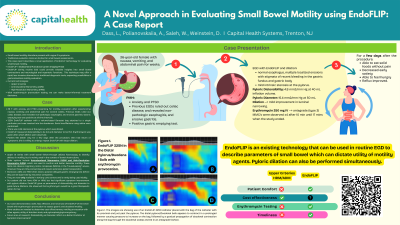Sunday Poster Session
Category: Interventional Endoscopy
P1073 - A Novel Approach in Evaluating Small Bowel Motility Using EndoFLIP
Sunday, October 27, 2024
3:30 PM - 7:00 PM ET
Location: Exhibit Hall E

Has Audio

Lucinda Dass, MD
Capital Health Regional Medical Center
Trenton, NJ
Presenting Author(s)
Lucinda Dass, MD, Wanda Saleh, MD, Anastasiia Polianovskaia, MD, Douglas Weinstein, MD
Capital Health Regional Medical Center, Trenton, NJ
Introduction: Motility disorders can be challenging to diagnose solely by clinical manifestations or radiologic findings. Traditional evaluation tools are limited for small bowel assessments. Upper GI series with small bowel follow-through utilizes fluoroscopy to identify defects in motility, but is mainly used in the context of bowel obstructions. Older options include Antroduodenal Manometry (ADM) and High-Resolution Manometry (HRM) which can observe migratory motor complexes (MMCs) or the “housekeeping” waves, but these are time-consuming and require extensive patient preparation. Our case describes a novel application of EndoFLIP in providing valuable insights into small bowel contractions and myenteric functions. It is performed under routine esophagogastroduodenoscopy (EGD) and allows for a dynamic assessment in a faster, less invasive method. With erythromycin provocation testing, we can make better-informed treatment decisions.
Case Description/Methods: A 36-year-old female with nausea, vomiting, and abdominal pain for several weeks presented for motility evaluation. Previous EGDs ruled out celiac disease, and revealed non-pathologic esophagitis, and erosive gastritis. Gastric emptying test was positive at all time intervals. EGD with EndoFLIP showed a normal esophagus, multiple localized erosions with stigmata of recent bleeding in the gastric fundus and gastric body, and a mild intrinsic stenosis at the pylorus. Once traversed, a 325N EndoFLIP catheter with a volume-based Barostat bag attached to a single perfusion port was inserted into the duodenum. Serial insufflations using saline were performed. Pyloric distensibility was 4.8 mm2/mm Hg at 40 mL inflation volume and 15.4 mm2/mm Hg at 50 mL. Dilation showed mild improvement in luminal narrowing. Erythromycin 250 mg IV was given and several antegrade MMC's were observed after 10 minutes.
Discussion: Our case demonstrates a safe, fast, effective, and novel use of EndoFLIP of the small bowel with erythromycin provocation to assess gastric and duodenal motility. ADM and HRM are more used in the pediatric population and at tertiary care centers. The commonly used upper GI series detects shapes and sizes of digestive organs and can identify filling defects. Endoflip has the advantage of being performed during routing EGD, saving patients from extensive preparation, conserving time, and offering the advantage of the ability to perform dilation in case of stenosis. Moreover, we were able to advise our patient on the utility of erythromycin therapy.
Disclosures:
Lucinda Dass, MD, Wanda Saleh, MD, Anastasiia Polianovskaia, MD, Douglas Weinstein, MD. P1073 - A Novel Approach in Evaluating Small Bowel Motility Using EndoFLIP, ACG 2024 Annual Scientific Meeting Abstracts. Philadelphia, PA: American College of Gastroenterology.
Capital Health Regional Medical Center, Trenton, NJ
Introduction: Motility disorders can be challenging to diagnose solely by clinical manifestations or radiologic findings. Traditional evaluation tools are limited for small bowel assessments. Upper GI series with small bowel follow-through utilizes fluoroscopy to identify defects in motility, but is mainly used in the context of bowel obstructions. Older options include Antroduodenal Manometry (ADM) and High-Resolution Manometry (HRM) which can observe migratory motor complexes (MMCs) or the “housekeeping” waves, but these are time-consuming and require extensive patient preparation. Our case describes a novel application of EndoFLIP in providing valuable insights into small bowel contractions and myenteric functions. It is performed under routine esophagogastroduodenoscopy (EGD) and allows for a dynamic assessment in a faster, less invasive method. With erythromycin provocation testing, we can make better-informed treatment decisions.
Case Description/Methods: A 36-year-old female with nausea, vomiting, and abdominal pain for several weeks presented for motility evaluation. Previous EGDs ruled out celiac disease, and revealed non-pathologic esophagitis, and erosive gastritis. Gastric emptying test was positive at all time intervals. EGD with EndoFLIP showed a normal esophagus, multiple localized erosions with stigmata of recent bleeding in the gastric fundus and gastric body, and a mild intrinsic stenosis at the pylorus. Once traversed, a 325N EndoFLIP catheter with a volume-based Barostat bag attached to a single perfusion port was inserted into the duodenum. Serial insufflations using saline were performed. Pyloric distensibility was 4.8 mm2/mm Hg at 40 mL inflation volume and 15.4 mm2/mm Hg at 50 mL. Dilation showed mild improvement in luminal narrowing. Erythromycin 250 mg IV was given and several antegrade MMC's were observed after 10 minutes.
Discussion: Our case demonstrates a safe, fast, effective, and novel use of EndoFLIP of the small bowel with erythromycin provocation to assess gastric and duodenal motility. ADM and HRM are more used in the pediatric population and at tertiary care centers. The commonly used upper GI series detects shapes and sizes of digestive organs and can identify filling defects. Endoflip has the advantage of being performed during routing EGD, saving patients from extensive preparation, conserving time, and offering the advantage of the ability to perform dilation in case of stenosis. Moreover, we were able to advise our patient on the utility of erythromycin therapy.
Disclosures:
Lucinda Dass indicated no relevant financial relationships.
Wanda Saleh indicated no relevant financial relationships.
Anastasiia Polianovskaia indicated no relevant financial relationships.
Douglas Weinstein indicated no relevant financial relationships.
Lucinda Dass, MD, Wanda Saleh, MD, Anastasiia Polianovskaia, MD, Douglas Weinstein, MD. P1073 - A Novel Approach in Evaluating Small Bowel Motility Using EndoFLIP, ACG 2024 Annual Scientific Meeting Abstracts. Philadelphia, PA: American College of Gastroenterology.
